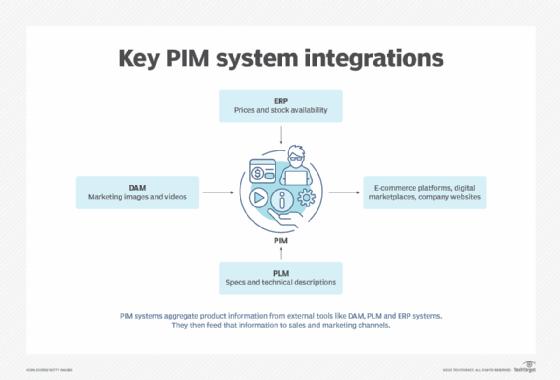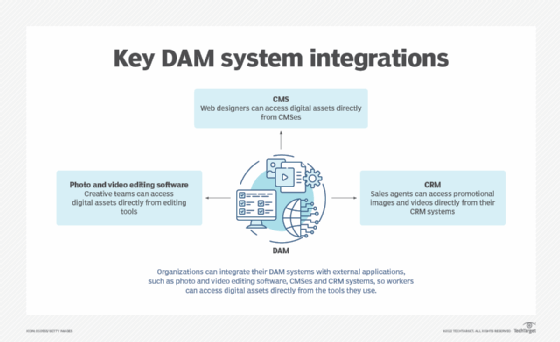
Getty Images/iStockphoto
PIM vs. DAM: What's the difference?
PIM and DAM systems help retailers manage information, but they focus on different information types. PIM systems aggregate product details, whereas DAM systems store multimedia.
As online retailers sell products across multiple channels, PIM and DAM systems help them manage their product and marketing information.
Modern retailers can easily mismanage their data. For instance, product listings may display outdated prices or inaccurate product images, which can frustrate customers and harm organizations' customer experience. As retailers search for a software tool that can manage product information, they may come across advertisements for product information management (PIM) and digital asset management (DAM) systems, but not understand the difference between them.
To ensure that retailers and digital marketing teams choose the right systems for their needs, they should learn the key differences between PIM and DAM systems, which include their overall purposes, the types of content they manage and the tools they integrate with.
What is PIM?
PIM is a category of software products that store, organize, manage and distribute basic product information to ensure consistency across sales and marketing channels. These systems aggregate product data from tools like ERP and product lifecycle management (PLM) systems into a central repository.
PIM systems often store the following types of information:
- product specifications
- price
- weight
- size
- dimensions
What is DAM?
DAM is a classification of software products that store, manage and distribute an organization's rich digital media assets, like audio and video content. This content may include the following:
- audio recordings
- product images
- brand logos
- podcasts
- promotional videos
Organizations that store many product-related assets, such as product images and videos, may integrate their DAM systems with a PIM system to create a single source of truth (SSOT) for their product data.
3 differences between PIM and DAM
Although PIM and DAM systems both serve as content repositories, they differ in terms of their purposes, the content they store and external tools that organizations can integrate them with.
1. Purpose
PIM systems help organizations maintain accurate product information across marketing and sales channels. DAM systems, on the other hand, help creative teams manage rich digital media assets.
As organizations engage in multichannel marketing and selling, they may struggle to maintain accurate and consistent product information across channels, like company websites, social media and e-commerce platforms. Products and their features often change over time, which can create inconsistencies between channels if teams don't update them often enough. PIM systems help organizations manage these changes.
For instance, a beauty product company may adjust the price, bottle size or ingredients of one of its shampoos. With a PIM system in place, the marketing team doesn't have to manually change the information on every marketing and sales platform. Instead, they can make updates in the PIM system, which can automatically update data across channels.
A DAM system, on the other hand, lets creative professionals like graphic designers and video editors easily retrieve and collaborate on projects. Versioning features track different file variations as creative teams edit them, which can help teams locate the most up-to-date versions of assets.
Additionally, DAM systems offer live commenting features that enable creative teams to collaborate on projects through integrations with external editing apps.
Because DAM systems offer an SSOT for digital assets like company logos, organizations often use them to maintain brand consistency across channels. System admins can create and upload brand guidelines, such as design templates and color schemes, to the system and update them as changes occur.
2. Content
PIM systems manage different types of content than DAM systems. PIM systems collect, store, organize and distribute basic product information, such as a product's physical attributes. DAM systems manage larger, more creative files, like images and videos for marketing and sales teams.
PIM systems store the following types of content:
- bar code number
- product title
- weight
- dimensions
- size
- color
- materials
- stock availability
- product description
- marketing copy
- SEO keywords
Creative teams generally use DAM systems to manage the following content types:
- brand logos
- branding templates
- product images
- promotional videos
- product demos
- customer testimonials
- podcasts
3. Integrations
To get the most out of PIM and DAM systems, organizations can integrate the tools with external apps to create marketing software sets. However, organizations integrate PIM and DAM systems with different kinds of tools.
Retailers typically integrate their PIM systems with the following apps:
- ERP system. ERP systems record and manage financial, HR, sales and supply chain transactions across organizations. They often manage data such as product prices and stock availability, which PIM systems can aggregate into a central repository.
- PLM system. PLM systems help product development teams manage products from inception to retirement. Through integration, PLM systems can share product specs, 3D models and technical descriptions with PIM systems.
- E-commerce platform. PIM systems can feed accurate and up-to-date product information to different e-commerce platforms.

Additionally, retailers integrate DAM systems with the following platforms:
- CRM system. Sales agents use CRM systems to interact with customers and leads, so they need access to accurate and up-to-date promotional content. CRM and DAM integration can let sales agents easily access product-related assets.
- Content management system (CMS). Organizations often integrate their DAM systems with a CMS so website designers can access images and videos from the CMS.
- Photo and video editing software. DAM systems can integrate with editing software like Adobe Photoshop and Avid Media Composer so creative teams can access their asset libraries directly from their editing tools.

Additionally, retailers may integrate their PIM and DAM platforms with each other. DAM systems often store content like product images and promotional videos, and an integration can create a 360-degree view of product information.
PIM vs. DAM: Which should retailers choose?
PIM systems can benefit any organization that manages an e-commerce store. However, any organization with a large, complex and dynamic product catalog or that markets across multiple channels can benefit from a PIM system.
Organizations that manage a lot of rich multimedia assets may consider a DAM system. In the past, primarily media and publishing companies used DAM systems. However, with the rise of digital marketing, more organizations in various industries rely on podcasts and video content to promote their products. DAM systems can help any organization that struggles to manage its multimedia content.
In many cases, organizations may integrate PIM and DAM systems with each other. For instance, if a retailer manages a large e-commerce site and many product-related digital assets, a PIM and DAM integration can link those assets to their respective products in the PIM system.
As more organizations embrace e-commerce, PIM and DAM systems become increasingly important. PIM systems can help online retailers offer accurate product information across channels, whereas DAM systems can optimize workflows as creative teams devise, edit and publish marketing content.








